An Analysis of the Heat Transfer Characteristics of Medium-Shallow Borehole Ground Heat Exchangers with Various Working Fluids
Abstract
:1. Introduction
2. Heat Transfer Model
2.1. Description of the Borehole Heat Transfer Problem
- (1)
- The radial boundary is sufficiently far, and it can be regarded as an adiabatic boundary.
- (2)
- The soil around the BGHE is regarded as one or several horizontal formations of uniform medium, each layer is a uniform medium, and its thermal properties do not change with temperature.
- (3)
- The working fluid maintains a turbulent flow state in the borehole, and the physical properties of the working fluid do not change with temperature.
- (4)
- The terrestrial heat flow qg, W/m2, is considered to be evenly distributed in the underground soil area.
- (5)
- In the initial time domain, there is no disturbance everywhere, and the steady-state temperature distribution and uniform initial ground temperature are maintained.
2.2. Flow Heat Transfer Model of the Working Fluid
2.3. Introduction of the Dimension Reduction Algorithm for Multiple BGHEs
3. Model Validation
4. Analysis and Comparison of the Working Fluid
4.1. Heat Transfer Performance of BGHEs
4.2. Pressure Loss and Coefficient of the Performance of BGHEs
4.3. Environmental Benefit and Economic Analysis of BGHEs
5. Multiple Medium-Shallow Borehole Heat Exchangers
6. Conclusions
- (1)
- The heat transfer models were shown to be reasonable by the experimental test data, and these models could lay a firm foundation for the calculation of medium-shallow geothermal resources providing heating and cooling for buildings.
- (2)
- This article defined a quantitative indicator called the “heat transfer index” to represent the heat transfer capacity of BGHEs. CO2 provided the highest heat transfer, followed by water. Moreover, it was found that when the burial depth of the borehole reached 300 m, its heating capacity was higher than its cooling capacity. After four months of continuous operation, R600a exhibited the highest outlet temperature during the winter. However, the heat loss rate was also the highest. Due to the higher dynamic viscosity coefficient of water, it results in a larger pressure loss, with a value of 83.06 kPa. Therefore, from the analysis of the heat transfer performance and pump power consumption, R600a and CO2 were more suitable than water.
- (3)
- The effect of the working fluid type on the environmental benefits and carbon reduction potential of medium-shallow BGHEs was studied. It was found that R600a, R134a, pentane, and CO2 all showed excellent environmental benefits, while the annual emission reduction and net heat of water was the lowest, and their values were 44.11% and 53.74% lower than CO2, respectively. Especially when CO2 was selected as the working fluid, the carbon emissions into the atmosphere by CO2 emission sources such as thermal power plants could be reduced. Finally, combined with economic analysis, CO2 yielded the lowest investment cost and the shortest payback period among the various organic working fluids in this paper.
- (4)
- The number of boreholes significantly affected the outlet temperature of the working fluid of BGHEs. In the heat extraction mode, when CO2 was selected as the working fluid for BGHEs and operated for 10 years, the outlet temperature was reduced by approximately 6% for the two-borehole form and by approximately 10% for the four-borehole form relative to the single-borehole form. The thermal interference between the BGHEs and the imbalance between the soil cooling and heating loads should be noted. It is recommended to activate the heat extraction mode during the winter season and the heat dissipation mode during the summer season.
Author Contributions
Funding
Institutional Review Board Statement
Informed Consent Statement
Data Availability Statement
Acknowledgments
Conflicts of Interest
Appendix A
References
- Li, Q.; Wang, F.L.; Wang, Y.L.; Zhou, C.; Chen, J.; Forson, K.; Miao, R.; Su, Y.; Zhang, J. Effect of reservoir characteristics and chemicals on filtration property of water-based drilling fluid in unconventional reservoir and mechanism disclosure. Environ. Sci. Pollut. Res. 2023, 30, 55034–55043. [Google Scholar] [CrossRef] [PubMed]
- Sönnichsen, N. Daily Demand for Crude Oil Worldwide from 2006 to 2020, with a Forecast Unit 2026. 2021. Available online: https://www/statista.com/statistics/271823/daily-global-crude-oil-demand-since-2006/ (accessed on 6 June 2023).
- Li, Q.; Zhao, D.; Yin, J.; Zhou, X.; Li, Y.; Chi, P.; Han, Y.; Ansari, U.; Cheng, Y. Sediment instability caused by gas production from hydrate-bearing sediment in Northern South China Sea by horizontal wellbore: Evolution and Mechanism. Nat. Resour. Res. 2023, 32, 1595–1620. [Google Scholar] [CrossRef]
- Wang, Y.Q.; Liu, Y.X.; Dou, J.Y.; Li, M.Z.; Zeng, M. Geothermal energy in China:status, challenges, and policy recommendations. Util. Pol. 2020, 64, 101020. [Google Scholar] [CrossRef]
- Lyu, W.H.; Li, X.T.; Wang, B.L.; Shi, W.X. Energy saving potential of fresh air pre-handling system using shallow geothermal energy. Energy Build 2019, 185, 39–48. [Google Scholar] [CrossRef]
- Ma, B.; Jia, L.X.; Yu, Y.; Wang, H. The development and utilization of geothermal energy in the world. Geol. China 2021, 48, 1734–1747. [Google Scholar]
- Chen, S.Y.; Zhang, Q.; Li, H.L.; Mclellan, B.; Zhang, T.T.; Tan, Z.Z. Investment decision on shallow geothermal heating & cooling based on compound options model: A case study of China. Appl Energy 2019, 254, 113655. [Google Scholar]
- Omer, A.M. Ground-source heat pumps systems and applications. Renew. Sustain. Energy Rev. 2008, 12, 344–371. [Google Scholar] [CrossRef]
- Rybach, L.; Hopkirk, R.J. Shallow and deep borehole heat exchangers-Achievements and prospects. In Proceedings of the World Geothermal Congress, International Geothermal Association, Florence, Italy, 18–31 May 1995; pp. 2133–2138. [Google Scholar]
- Ingersoll, L.R.; Zobel, O.J.; Ingersoll, A.C. Heat Conduction with Engineering, Geological, and Other Applications; University of Wisconsin Press: Madison, WI, USA, 1954; pp. 66–78. [Google Scholar]
- Zeng, H.Y.; Diao, N.R.; Fang, Z.H. A model of finite-length linear heat-source for the vertical embedded pipe of a ground-source heat pump. Eng. Therm. Energy Power 2003, 2, 166–170+216. [Google Scholar]
- Tranter, C.J. Conduction of Heat in Solids, 2nd ed.; Clarendon Press: Oxford, UK, 1959. [Google Scholar]
- Diao, N.R.; Zeng, H.Y.; Fang, Z.H. Improvement on modelling of heat transfer in vertical ground heat exchanger. Int. J. HVACR Res. 2004, 10, 450–470. [Google Scholar]
- Zeng, H.; Diao, N.; Fang, Z. Heat transfer analysis of boreholes in vertical ground heat exchangers. Int. J. Heat Mass Transf. 2003, 46, 4467–4481. [Google Scholar] [CrossRef]
- Mahmoodpour, S.; Singh, M.; Turan, A.; Bär, K.; Sass, I. Simulations and global sensitivity analysis of the thermo-hydraulic-mechanical processes in a fractured geothermal reservoir. Energy 2022, 247, 123511. [Google Scholar] [CrossRef]
- Amiri, D.A.; Sajjadi, H.; Ahmadi, G. The Effect of Piezoelectric Transducer Location on Heat Transfer Enhancement of an Ultrasonic-Assisted Liquid-Cooled CPU Radiator. Iran. J. Sci. Technol. Trans. Mech. Eng. 2023, 1–14. [Google Scholar] [CrossRef]
- Lyu, Z.; Song, X.; Li, G.; Hu, X.; Shi, Y.; Xu, Z. Numerical Analysis of Characteristics of a Single U-tube Downhole Heat Exchanger in the Borehole for Geothermal Wells. Energy 2017, 125, 186–196. [Google Scholar] [CrossRef]
- Li, J.; XU, W.; Li, J.F. Heat supply technology review and engineering measurement analysis of medium and deep buried pipes. Heat. Vent. Air Cond. HVAC 2020, 50, 35–39. [Google Scholar]
- Deng, J.; Wei, Q.; He, S.; Liang, M.; Zhang, H. Simulation analysis on the heat performance of deep borehole heat exchangers in medium-depth geothermal heat pump systems. Energies 2020, 13, 754. [Google Scholar] [CrossRef]
- Welsch, B.; Rühaak, W.; Schulte, D.O. Characteristics of medium deep borehole thermal energy storage. Int. J. Energy Res. 2016, 40, 1855–1868. [Google Scholar] [CrossRef]
- Cai, W.; Wang, F.; Chen, S.; Chen, C.; Liu, J.; Deng, J.; Kolditz, O.; Shao, H. Analysis of heat extraction performance and long-term sustainability for multiple deep borehole exchanger array: A project-based study. Appl. Energy 2021, 289, 116590. [Google Scholar] [CrossRef]
- Yu, M.; Lu, W.; Zhang, F.; Zhang, W.; Cui, P.; Fang, Z.H. A novel model and heat extraction capacity of mid-deep buried U-bend pipe ground heat exchangers. Energy Build. 2021, 235, 110723. [Google Scholar]
- Yuan, Y.P.; Lei, B.; Yu, N.Y.; Cao, X.L.; Zhang, D. Heat transfer of ground heat exchange for GSGP(1): A review. Heat. Vent. Air Cond. HVAC 2008, 38, 25–31. [Google Scholar]
- Saeed, M.; Mrityunjay, S.; Kristian, B.; Sass, B. Thermo-hydro-mechanical modeling of an enhanced geothermal system in a fractured reservoir using carbon dioxide as heat transmission fluid-A sensitivity investigation. Energy 2022, 254, 124266. [Google Scholar]
- Mrityunjay, S.; Saeed, M.; Reza, E.; Soltanian, M.R.; Sass, I. Comparative study on heat extraction from Soultz-sous-Forêts geothermal field using supercritical carbon dioxide and water as the working fluid. Energy 2023, 266, 126388. [Google Scholar]
- Wang, X.; Yao, H.; Li, J. Experimental and numerical investigation on heat transfer characteristics of ammonia thermosyhpons at shallow geothermal temperature. Int. J. Heat Mass Tran. 2019, 136, 1147–1159. [Google Scholar] [CrossRef]
- Pumaneratkul, C.; Yamasaki, H.; Yamaguchi, H. Supercritical CO2 Rankine cycle system with low-temperature geothermal heat pipe. Energy Procedia 2017, 105, 1029–1036. [Google Scholar] [CrossRef]
- Yildirim, N.; Parmanto, S.; Akkurt, G.G. Thermodynamic assessment of downhole heat exchangers for geothermal power generation. Renew. Energy 2019, 141, 1080–1091. [Google Scholar] [CrossRef]
- Shi, Y.; Bai, Z.; Feng, G.; Tian, H.; Bai, H. Performance analysis of medium-depth coaxial heat exchanger geothermal system using CO2 as a circulating fluid for building heating. Arab. J. Geosci. 2021, 14, 1308. [Google Scholar] [CrossRef]
- Tchanche, B.F.; Papadakis, G.; Lambrinos, G.; Frangoudakis, A. Fluid selection for a low-temperature solar organic Rankine cycle. Appl. Therm. Eng. 2009, 29, 2468–2476. [Google Scholar] [CrossRef]
- Zhang, T.A.; Wang, R.F.; Wang, F.H. Influence of sustainable load imbalance ratio of heat exchanger of medium-shallow borehole. Pet. Reserv. Eval. Dev. 2022, 12, 886–893. [Google Scholar]
- Diao, N.R.; Fang, Z.H. ; Ground-Coupled Heat Pump Technology; Higher Education Press: Beijing China, 2006. [Google Scholar]
- Zhang, F.; Fang, L.; Jia, L.; Man, Y.; Cui, P.; Zhang, W.; Fang, Z. A dimension reduction algorithm for numerical simulation of multi-borehole heat exchangers. Renew. Energy 2021, 179, 2235–2245. [Google Scholar]
- Gong, G.C. Fluid Transfer Nets; China Machine Press: Beijing, China, 2018.
- Phillipp, H.; Olaf, K.; Uwe-Jens, G.; Anke, B.; Shao, H. A numerical study on the sustainability and efficiency of borehole heat exchanger coupled ground source heat pump systems. Appl. Therm. Eng. 2016, 100, 421–433. [Google Scholar]
- United Nations Framework Convention on Climate Change Executive Board. Fossil Fuel Displacement by Geothermal Resources for Space Heating. Available online: https://cdm.unfccc.int/methodologies/index.html (accessed on 6 June 2023).

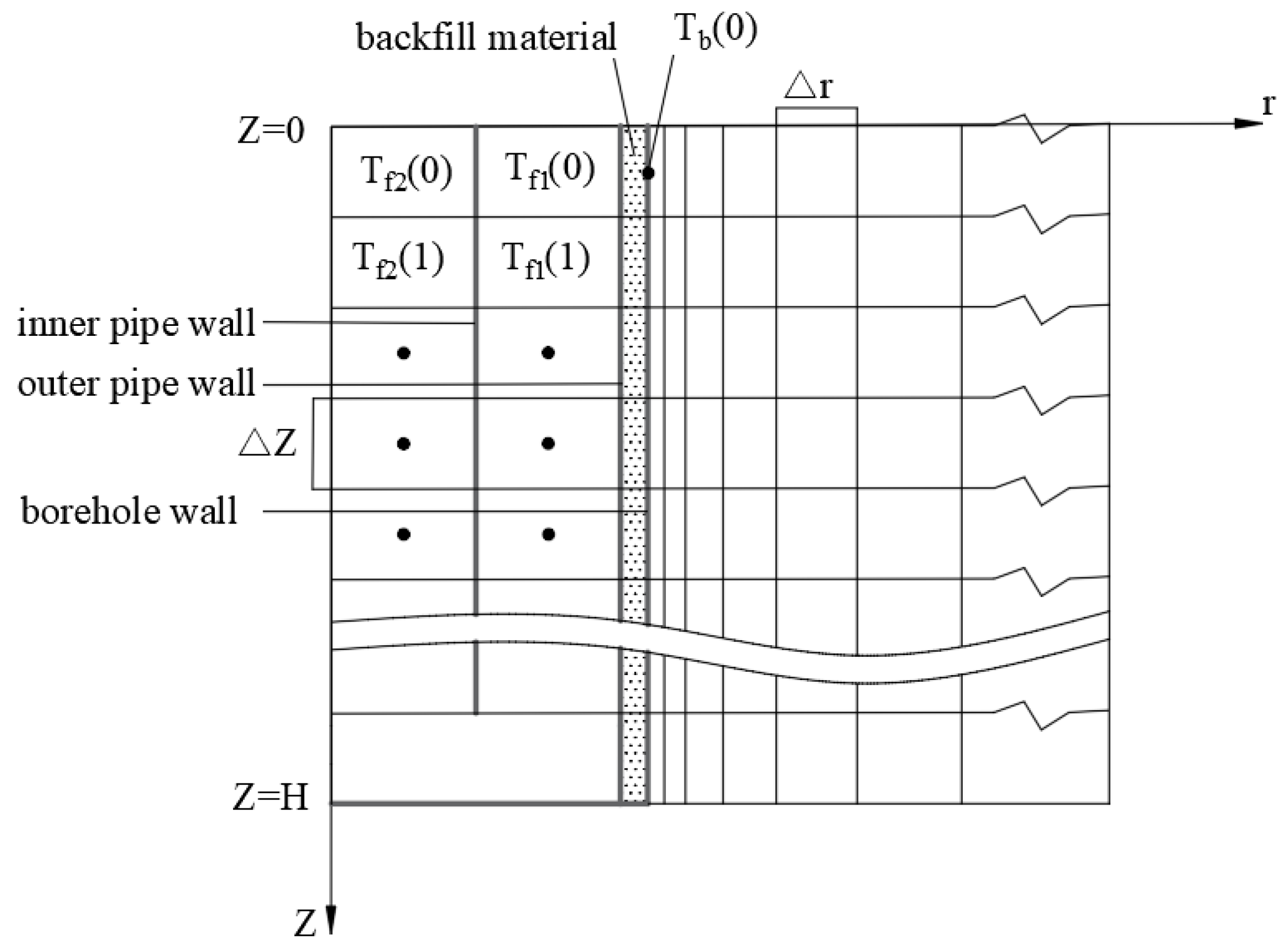
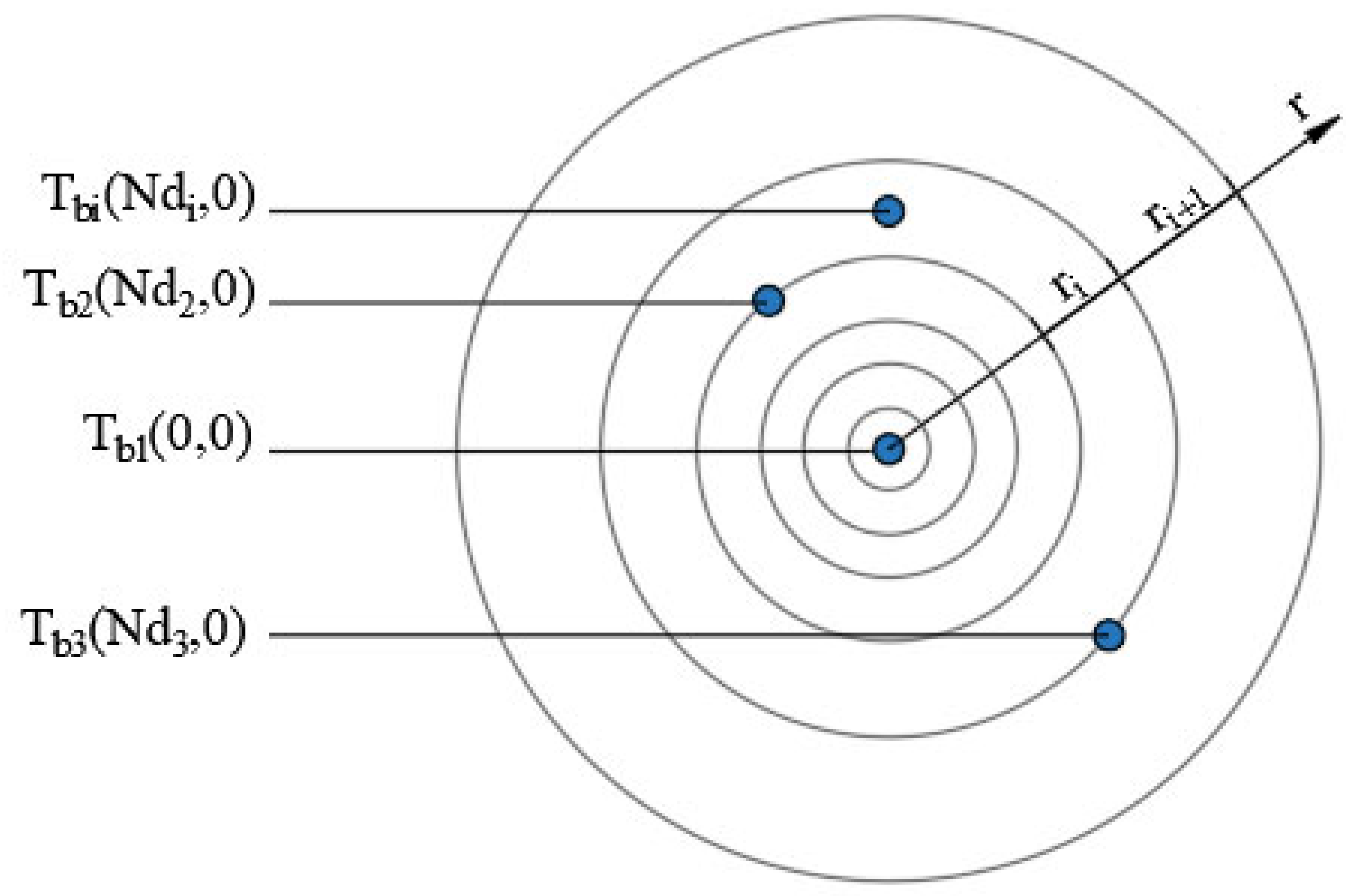
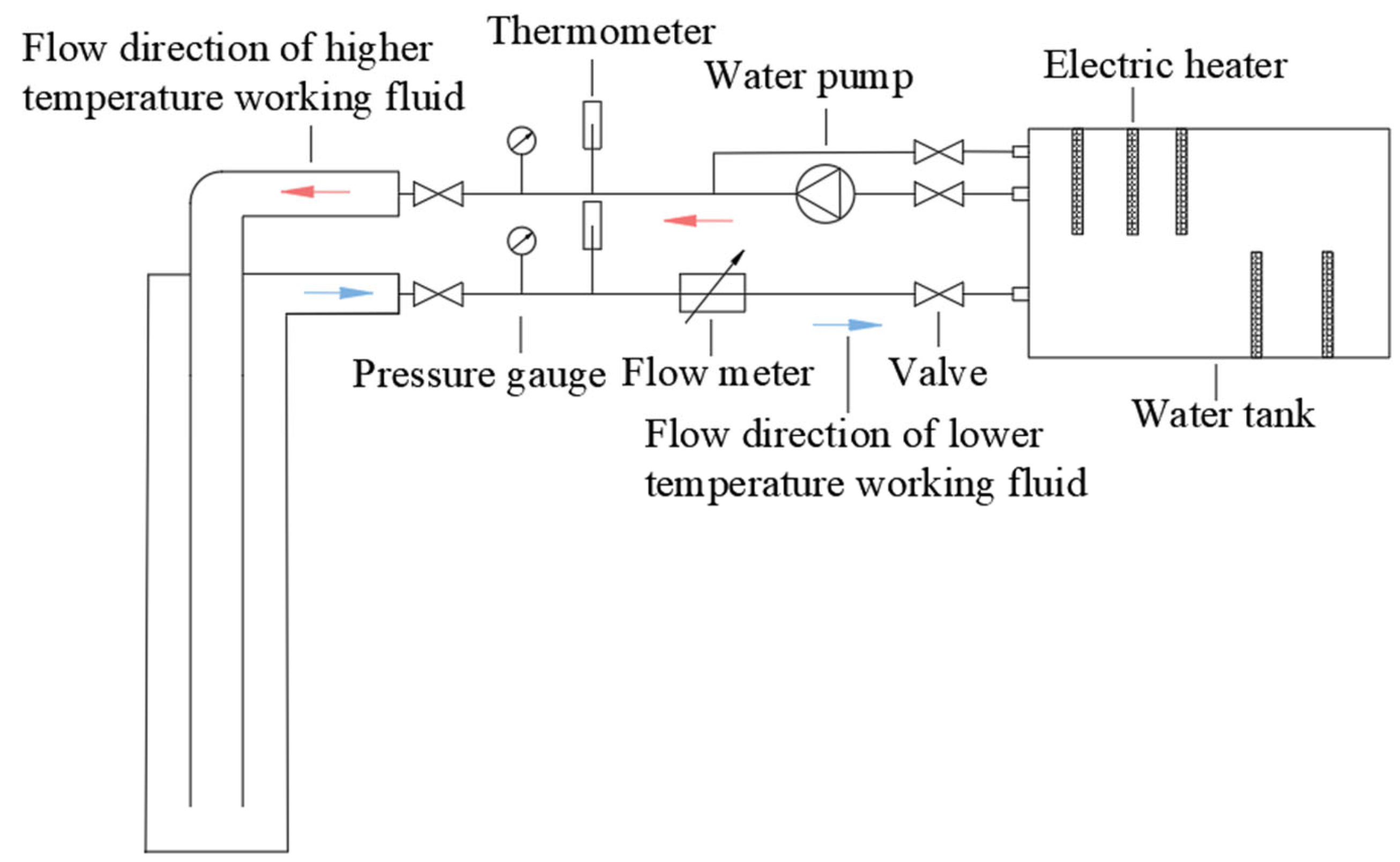
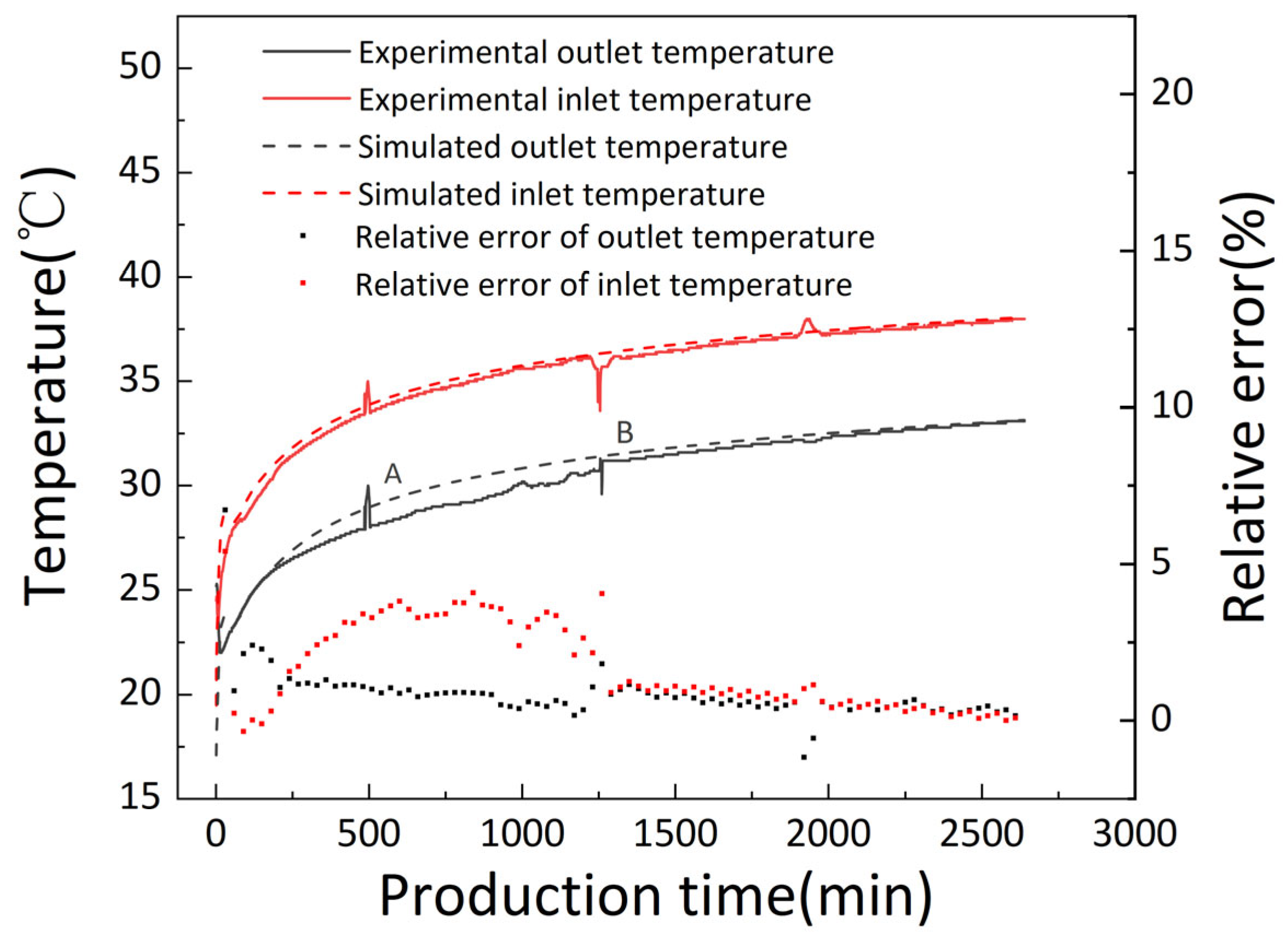
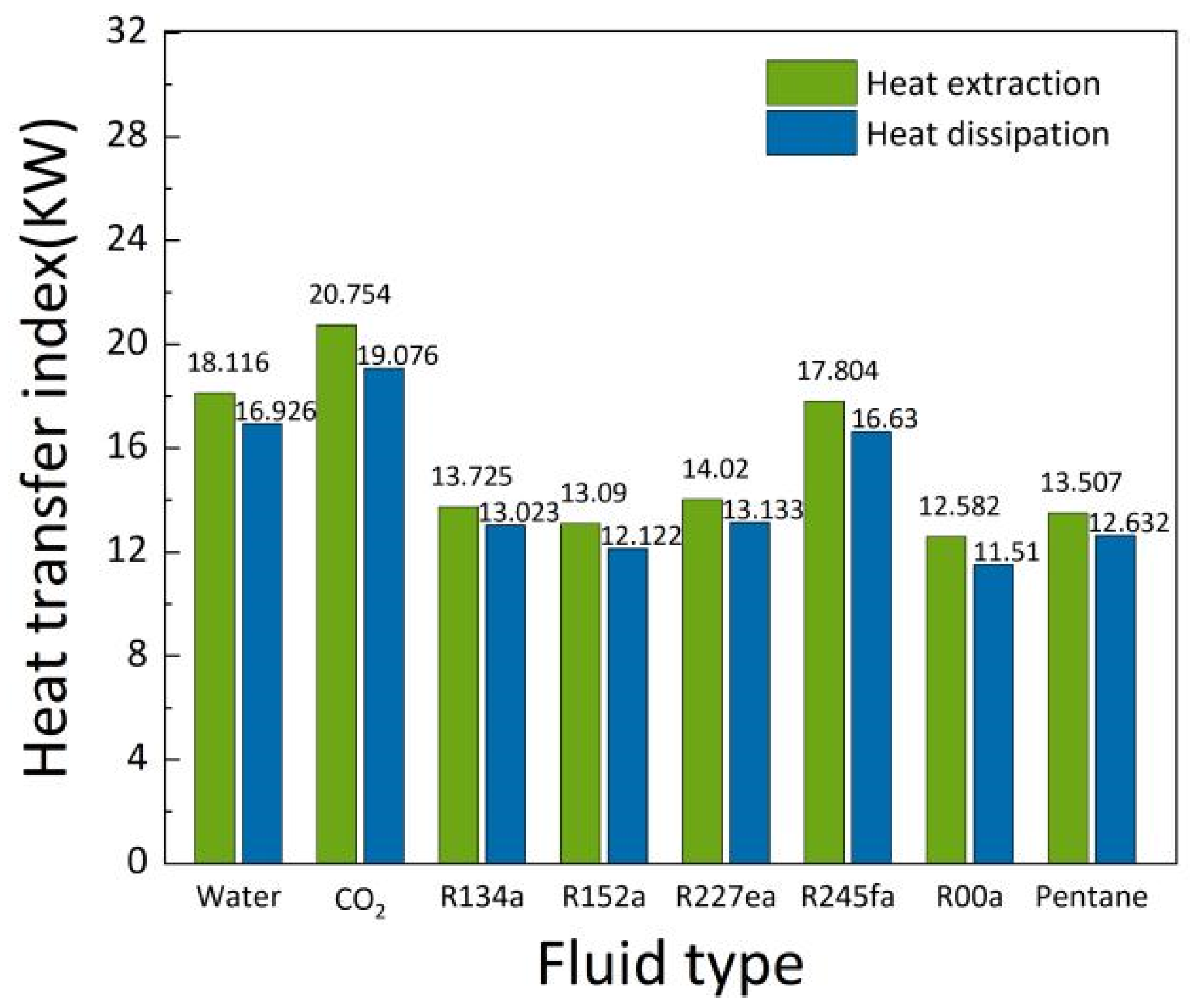

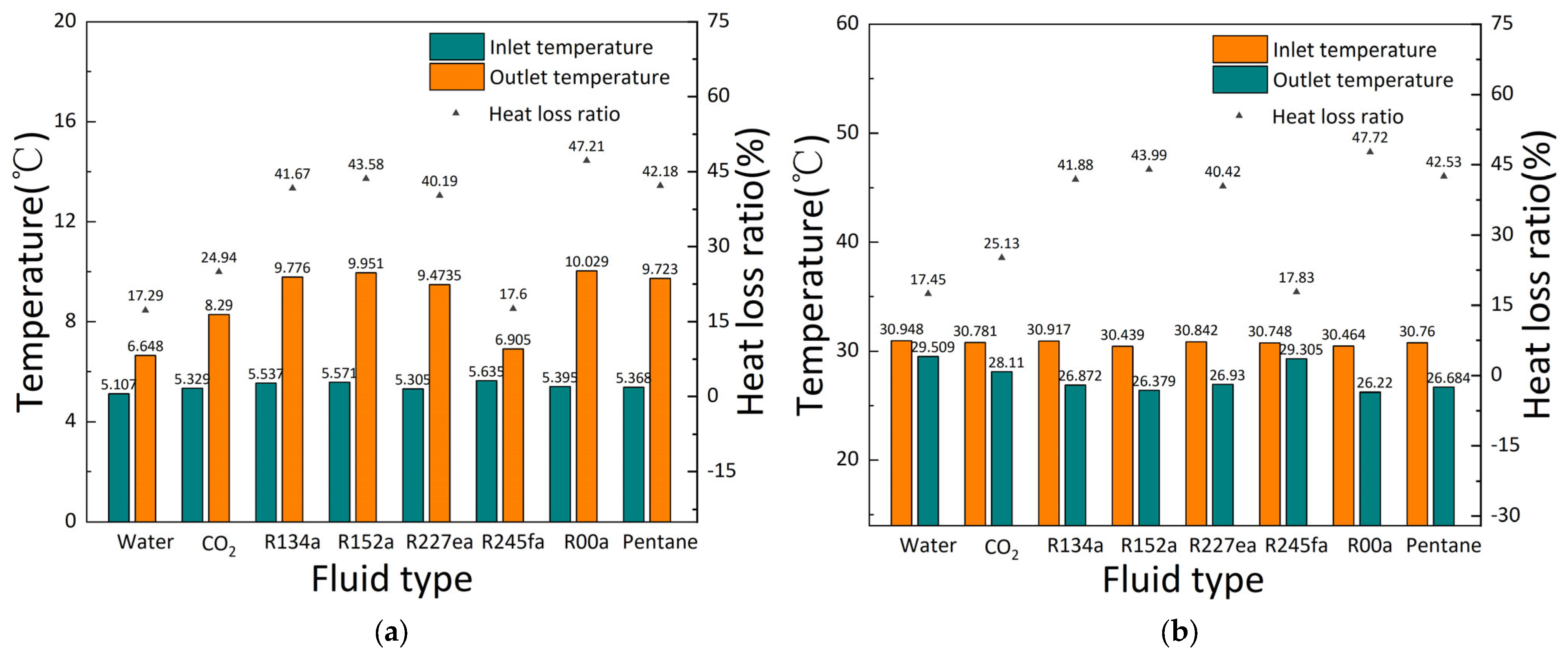
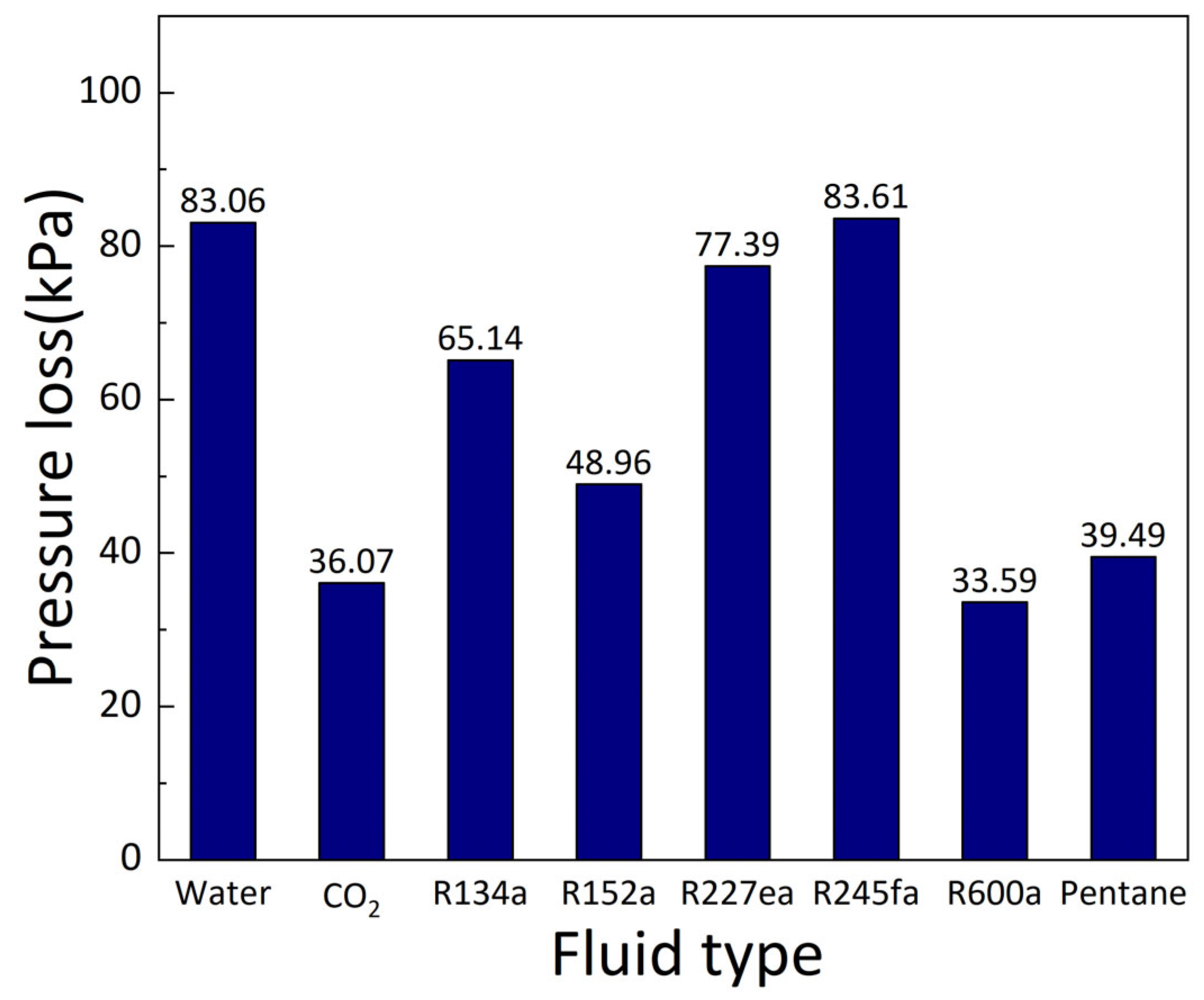
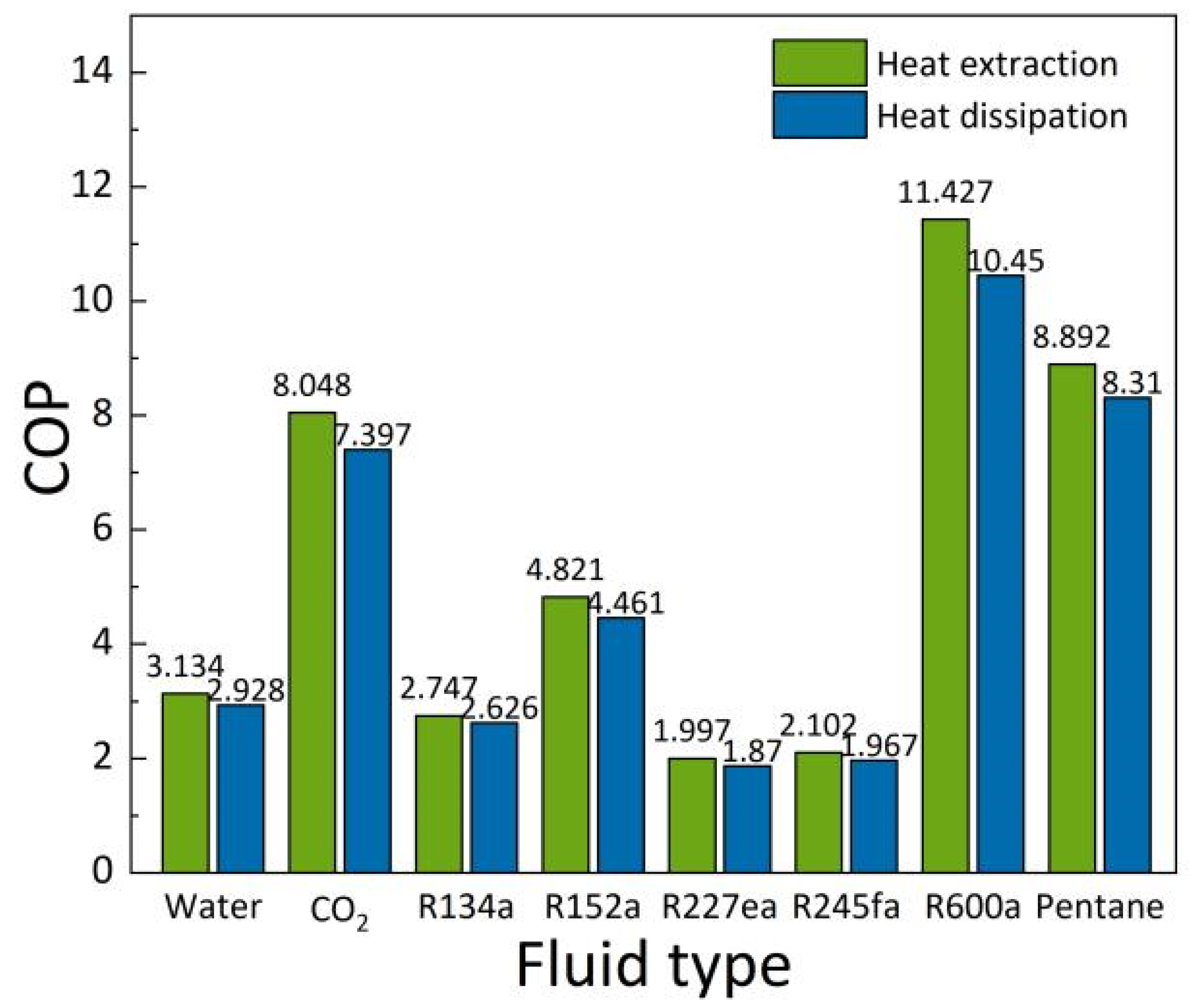
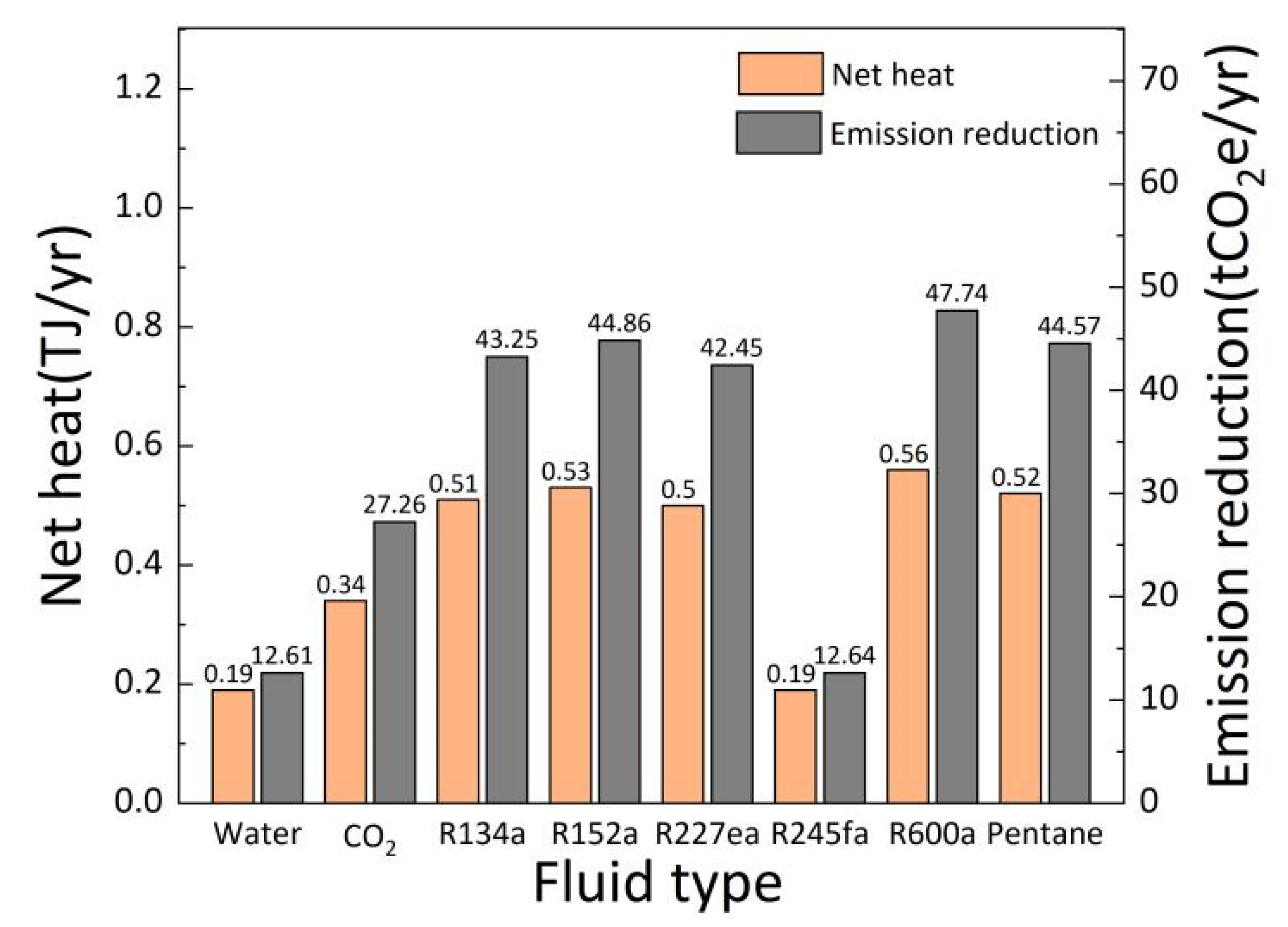
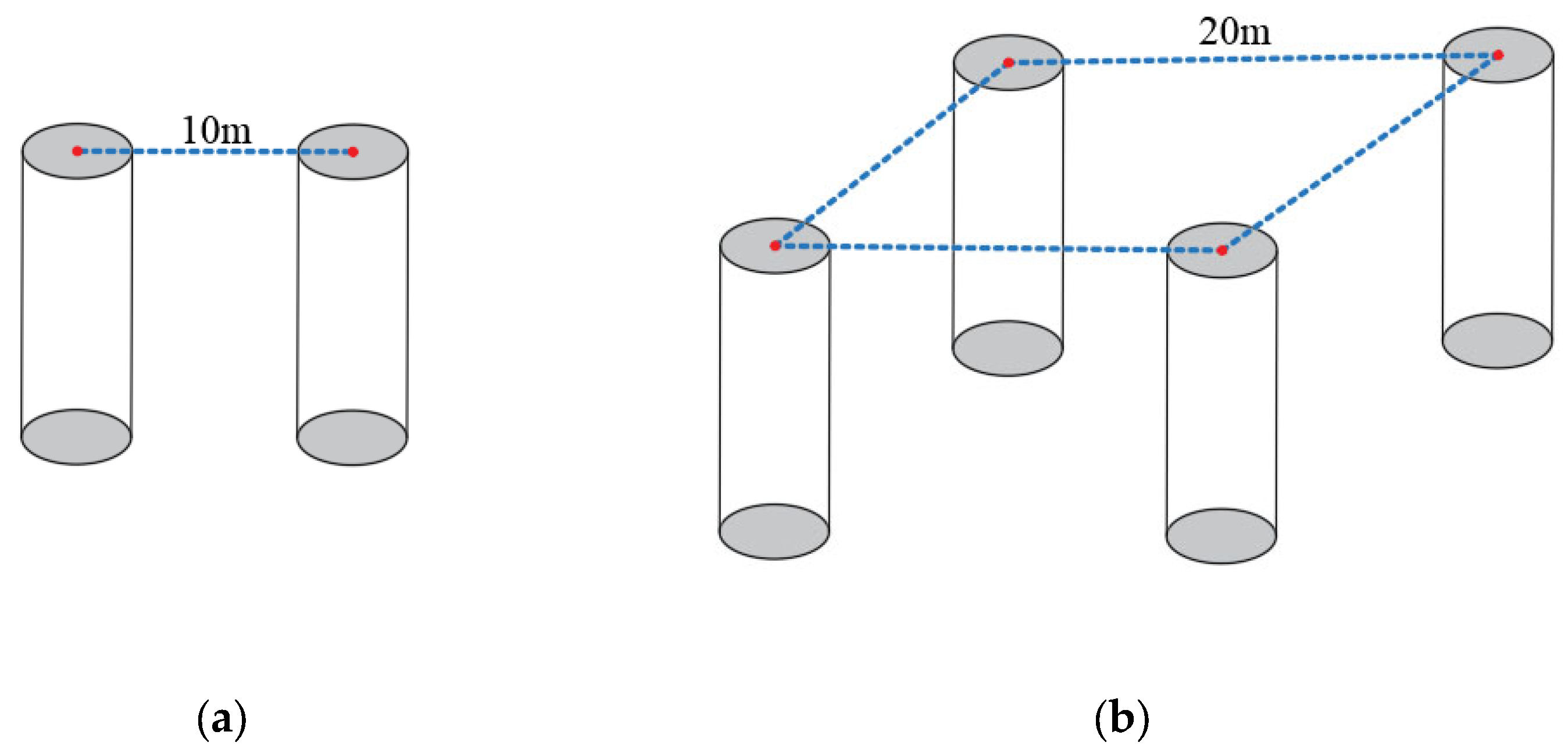
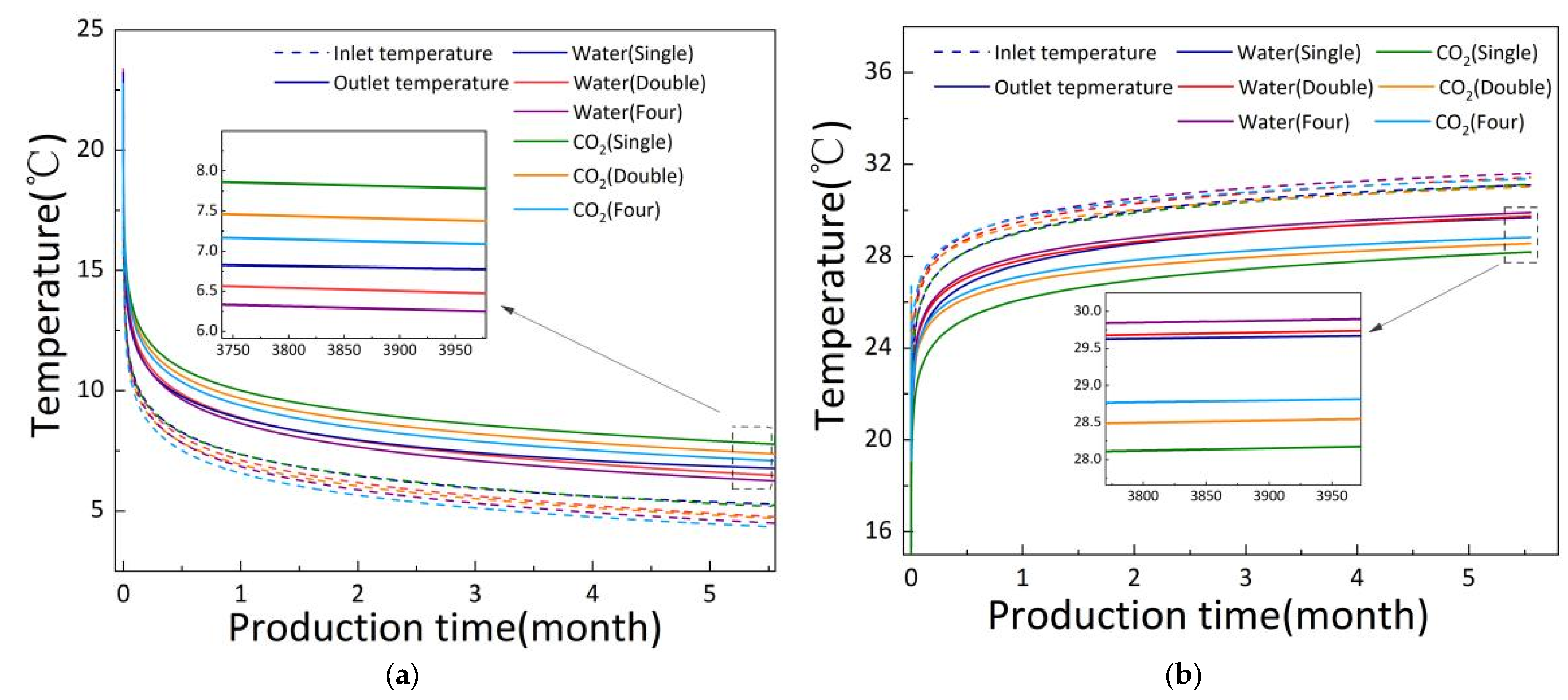
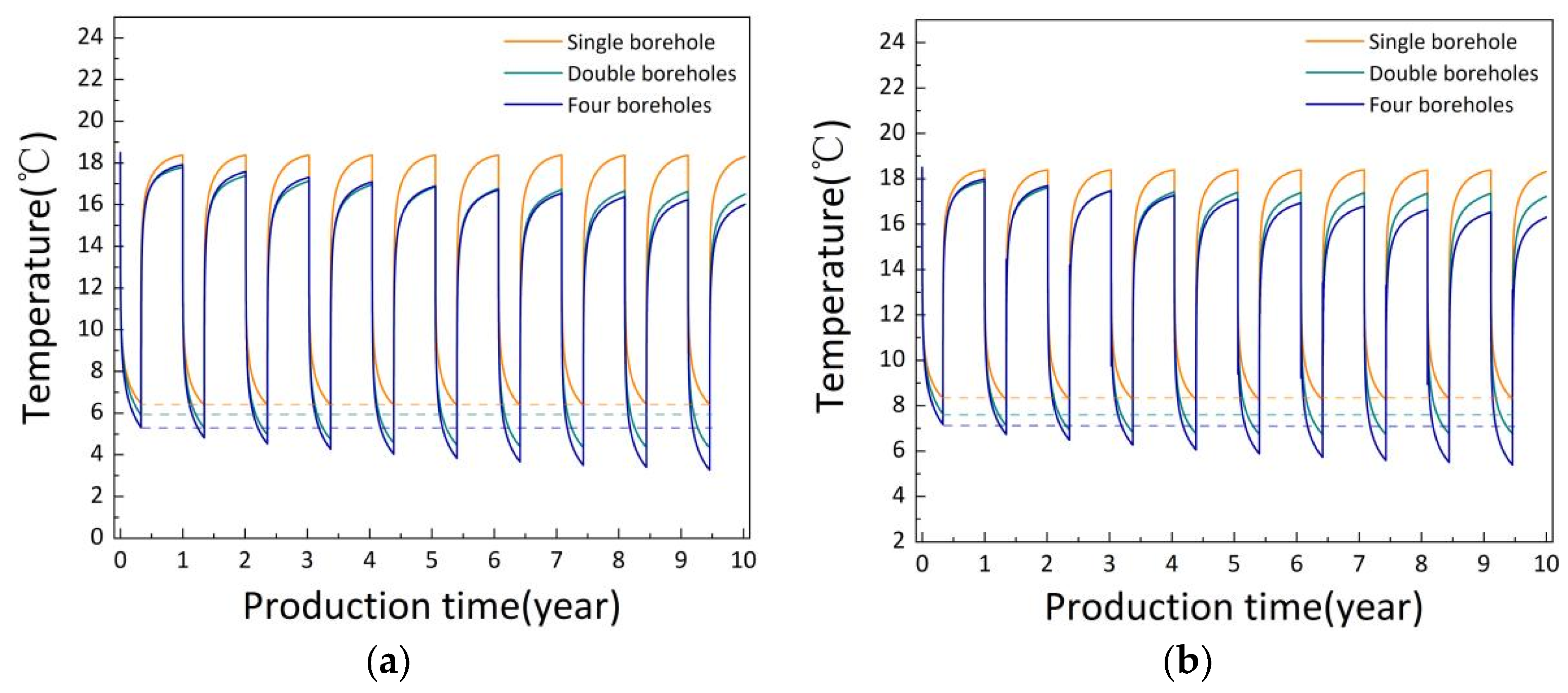
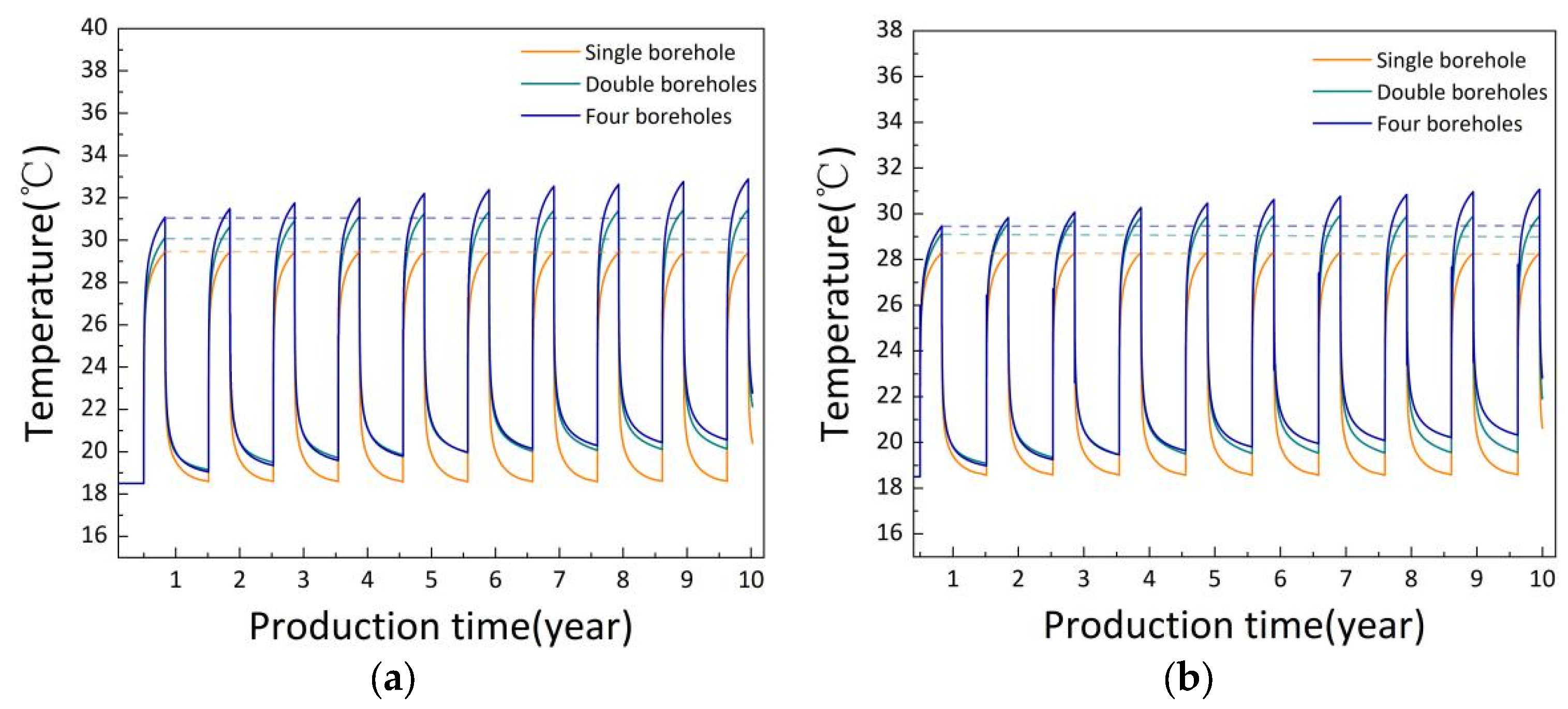
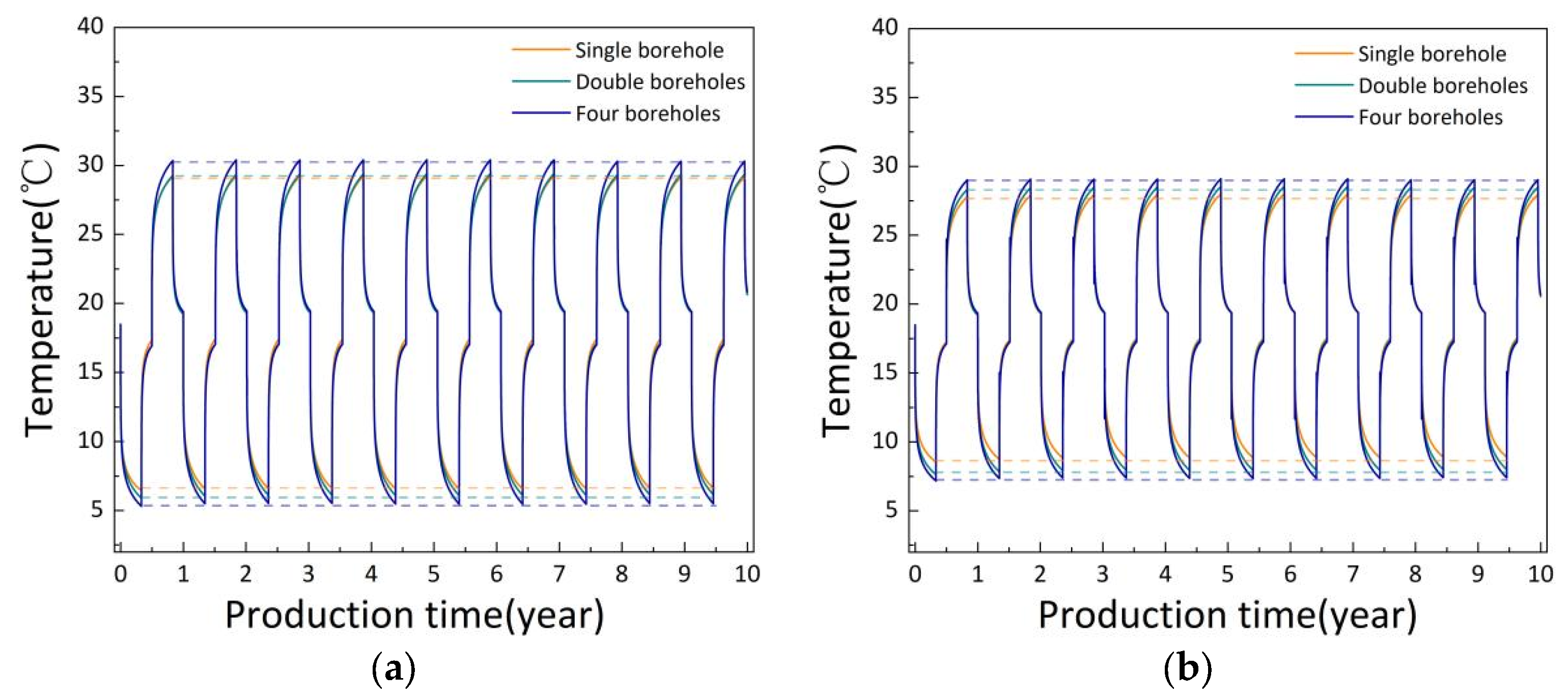
| Parameter/Unit | Symbol | Numerical Value |
|---|---|---|
| Drilling depth/(m) | H | 300 |
| Heating power/(kW) | Q | 19 |
| Circulating flow/(m3/h) | F | 3.5 |
| Import and outlet temperature difference of the circulating fluid (°C) | Δt | 4.5 |
| Drilling diameter/(m) | dbo | 0.133 |
| Outer tube outer diameter/(m) | d1o | 0.108 |
| Outer tube inner diameter/(m) | d1i | 0.099 |
| Outer tube surface roughness/(mm) | k1 | 0.046 |
| Inner tube outer diameter/(m) | d2o | 0.063 |
| Inner tube inner diameter/(m) | d2i | 0.0526 |
| Inner tube surface roughness/(mm) | k2 | 0.0015 |
| Geotechnical thermal conductivity/(W/(m·°C)) | λg | 2.09 |
| Thermal conductivity of outer tube/(W/(m·°C)) | λ1 | 45 |
| Thermal conductivity of inner tube/(W/(m·°C)) | λ2 | 0.24 |
| Thermal conductivity of backfill material/(W/(m·°C)) | λb | 1.83 |
| Volume specific heat capacity of soil/(J/(m3·°C)) | Cg | 2.46 × 106 |
| Volume specific heat capacity of outer tube/(J/(m3·°C)) | C1 | 3.45 × 106 |
| Volume specific heat capacity of inner tube/(J/(m3·°C)) | C2 | 1.9 × 106 |
| Volume specific heat capacity of backfill material/(J/(m3·°C)) | Cb | 2.42 × 106 |
| Volume specific heat capacity of working fluid/(J/(m3·°C)) | Cw | 4.187 × 106 |
| Working Fluid | Critical Pressure/(MPa) | Critical Temperature/(°C) |
|---|---|---|
| Water | 22.05 | 374.3 |
| CO2 | 7.2 | 31.2 |
| R134a (1,1,1,2-tetrafluoroethane) | 4.067 | 101.1 |
| R152a (1,1-difluoroethane) | 4.54 | 113.45 |
| R227ea (1,1,1,2,3,3,3-heptafluoropropane) | 2.98 | 102.8 |
| R245fa (1,1,1,3,3-pentafluoropropane) | 3.651 | 154 |
| R600a (isobutane) | 3.648 | 134.9 |
| Pentane | 3.37 | 196.5 |
| Parameter | Numerical Value |
|---|---|
| Heating area/(m2) | 1000 |
| Thermal index/(W/m2) | 50 |
| Total heating season heating hours /(h) | 2880 |
| Average geothermal water flow in heating season /(m3/h) | 25 |
| Working Fluid | Unit Price/(CNY/kg) | Initial Investment in Circulating Fluid/Ten Thousand CNY) |
|---|---|---|
| water | 0.0041 | 0.001383 |
| CO2 | 0.18 | 0.0492 |
| R134a | 24.5 | 10.37 |
| R152a | 16.5 | 5.17 |
| R227ea | 11 | 5.37 |
| R245fa | 60 | 27.72 |
| R600a | 100 | 19.18 |
| pentane | 90 | 19.23 |
Disclaimer/Publisher’s Note: The statements, opinions and data contained in all publications are solely those of the individual author(s) and contributor(s) and not of MDPI and/or the editor(s). MDPI and/or the editor(s) disclaim responsibility for any injury to people or property resulting from any ideas, methods, instructions or products referred to in the content. |
© 2023 by the authors. Licensee MDPI, Basel, Switzerland. This article is an open access article distributed under the terms and conditions of the Creative Commons Attribution (CC BY) license (https://creativecommons.org/licenses/by/4.0/).
Share and Cite
Wang, K.; Huang, T.; Zhang, W.; Zhang, Z.; Ma, X.; Zhang, L. An Analysis of the Heat Transfer Characteristics of Medium-Shallow Borehole Ground Heat Exchangers with Various Working Fluids. Sustainability 2023, 15, 12657. https://doi.org/10.3390/su151612657
Wang K, Huang T, Zhang W, Zhang Z, Ma X, Zhang L. An Analysis of the Heat Transfer Characteristics of Medium-Shallow Borehole Ground Heat Exchangers with Various Working Fluids. Sustainability. 2023; 15(16):12657. https://doi.org/10.3390/su151612657
Chicago/Turabian StyleWang, Kexun, Tishi Huang, Wenke Zhang, Zhiqiang Zhang, Xueqing Ma, and Leyao Zhang. 2023. "An Analysis of the Heat Transfer Characteristics of Medium-Shallow Borehole Ground Heat Exchangers with Various Working Fluids" Sustainability 15, no. 16: 12657. https://doi.org/10.3390/su151612657





